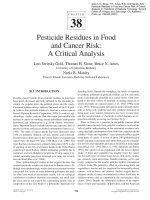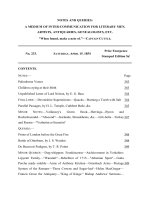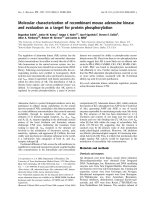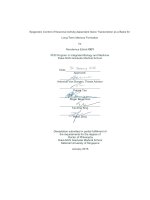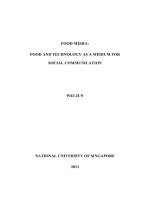Food media food and technology as a medium for social communication
Bạn đang xem bản rút gọn của tài liệu. Xem và tải ngay bản đầy đủ của tài liệu tại đây (5 MB, 263 trang )
FOOD MEDIA:
FOOD AND TECHNOLOGY AS A MEDIUM FOR
SOCIAL COMMUNICATION
WEI JUN
NATIONAL UNIVERSITY OF SINGAPORE
2013
FOOD MEDIA:
FOOD AND TECHNOLOGY AS A MEDIUM FOR
SOCIAL COMMUNICATION
WEI JUN
B. Eng. (Hons), Huazhong University of Science and
Technology
A THESIS SUBMITTED
FOR THE DEGREE OF DOCTOR OF
PHILOSOPHY
NUS GRADUATE SCHOOL FOR INTEGRATIVE
SCIENCE AND ENGINEERING
NATIONAL UNIVERSITY OF SINGAPORE
2013
i
Declaration
I hereby declare that this thesis is my original work and it has been
written by me in its entirety. I have duly acknowledged all the sources of
information which have been used in the thesis.
This thesis has also not been submitted for any degree in any university
previously.
Wei Jun
29 May 2014
ii
Acknowledgement
I would like to thank all those who supported me during my four years of PhD:
PhD supervisor: Prof. Shengdong Zhao; Co-supervisor: Prof. Ryohei Nakatsu;
previous supervisor: Prof. Adrian Cheok; Thesis Advisory Committee: Prof.
Roger Zimmermann and Prof. Cho Hichang, for their guidance, support and
encouragement during my research; and PhD thesis examiners.
Professors and research fellows in National University of Singapore and Keio
University in Japan: Prof. Ellen Yi-Luen Do, Prof. Masa Inakage, Prof. Henry
Duh, Prof. Kevin McGee, Prof. Okude Naohito, Prof. Masahiko Inami, Dr
Newton Fernando, Dr. Hideaki Nii, Dr. Jose Sepulveda, Dr. Xue Lishan, and
Prof. Mark Gross from Carnegie Mellon University.
I would like to express my appreciation to my research collaborators: Roshan
Peiris for his contribution in the development of Animated Tablecloth, Xavier
Roman on the food printer and Hosting Table, Remi Tache and Xuan Wang on
the Interaction Screen, Yongsoon Choi, Jeffrey Koh, and Veronica Halupka on
the design of CoDine prototype, former undergraduate students of NUS Qing
Zhu and Huan Tang, Dr. Darren Edge from Microsoft Research Asia in
Beijing, and Dr. Xiaojuan Ma from Huawei Noah’s Ark Lab in Hong Kong.
It is my pleasure to thank the members of Keio-NUS CUTE Center and NUS-
HCI Lab, providing their suggestions and feedback on this research: James
Teh, Eng Tat Khoo, Hooman Samani, Nimesha Ranasinghe, Dilrukshi
Abeyrathna, Weiquan Lu, Kening Zhu, Elham Saadatian, Kasun
Karunanayaka, , Shuang Yu, Haimo Zhang, Zhongyuan Zhang, Toni-Jan
Keith Monserrat, Chen Chen, Soon Hau Chua, Yongfeng Huang, Xiaojun
Meng, Chen Zhao, Marayam Azh, Rubaiat Habib Kazi, Shengdong Xu,
Anshul Pandey, Ng Pan Yew, Hiroki Nishino, Ron Huang, Chamari
Edirisinghe, James Chen, Dhairya Dand, and the admin staff. I am also
grateful to my department: NGS, the professional and friendly directors and
staffs, I feel very proud to be a member of the big family.
Last but not least, my parents and friends, it would be much more difficult for
me to go through this without your love, understanding and support along the
way.
iii
Contents
Declaration i
Acknowledgement ii
Contents iii
Summary vii
List of Tables x
List of Figures xi
1 Introduction 1
1.1 Research Motivation 1
1.2 Research Statement 5
1.3 Research Contributions 8
1.4 Thesis Overview 12
2 Conceptual Foundations 17
2.1 Social Communication and Interaction 17
2.1.1 Mediated Communication 18
2.1.2 Experience-oriented Communication 20
2.2 Communication Medium 22
2.2.1 Definition of Medium 23
2.2.2 Experience Medium 25
2.2.3 Summary 32
2.3 Food 33
2.3.1 Properties of Food 33
2.3.2 Functions of Food 35
2.3.3 Food-related Activities 39
2.4 Communicative Components of Food 40
2.4.1 Symbolism of Food in Communication 41
2.4.2 Distinguished Attributes of Food as a Social Medium 44
2.5 Summery 46
3 Literature Review 48
3.1 Communication and Mediated Co-experience 48
3.2 Food-mediated Communication 52
3.2.1 Overview 52
3.2.2 “Non-mediated” Eating 53
3.2.3 Food Gifting 56
iv
3.3 Digitalized Food-related Activities 58
3.3.1 Smart Cooking and Eating 58
3.3.2 Food Printing Technologies 60
3.4 Mediated Food Experience 62
3.4.1 Shared Cooking and Tasting Food 64
3.4.2 Social Eating Experience 65
3.5 Discussion 70
3.6 Summery 71
4 Methodology and Roadmap 73
4.1 Methodology 73
4.1.1 Design-oriented Research 73
4.1.2 Experience Prototyping 74
4.2 Research Roadmap 75
5 CoDine System 79
5.1 Overview 79
5.2 Background and Motivation 80
5.3 Experience-oriented Design 81
5.4 System Configuration 83
5.5 System Description and Implementation 84
5.5.1 Hosting Table 86
5.5.2 Animated Tablecloth 90
5.5.3 Food Teleportation 94
5.5.4 Interaction Screen 100
5.5.5 Summary 104
5.6 Evaluation 105
5.6.1 Study Overview 105
5.6.2 Evaluation Results 107
5.6.3 Study Summary 117
5.7 Discussion 119
6 Food Messaging 122
6.1 Overview 122
6.2 Background 124
6.3 System Description 126
6.3.1 Overview 126
6.3.2 Message Design Interface 127
6.3.3 System Testing 131
6.4 Study 1: Explore Design Space 134
v
6.4.1 Study Design 135
6.4.2 Findings 138
6.4.3 Study Summary 144
6.5 Study 2: Understand Food Social Language 145
6.5.1 Study Design 147
6.5.2 Participant 149
6.5.3 Study Results 149
6.5.4 Study Summary 156
6.5.5 Discussion 157
6.6 Discussion and Direction 159
6.6.1 Beyond Social Messaging 160
6.6.2 Points to Ponder 162
6.7 Summary 163
7 Experimental Field Study 165
7.1 Overview 165
7.2 Evaluation Objectives 166
7.3 Study Design 169
7.3.1 Food Messaging Service 169
7.3.2 Participants 171
7.3.3 Data Collection 173
7.4 Data Analysis 174
7.4.1 Codebook Creation 175
7.4.2 Coding Process 177
7.5 Results and Findings 178
7.5.1 Acceptance and Interest 178
7.5.2 Overall Rating in Surveys 180
7.5.3 Dimensions of Usage 183
7.6 Discussion 190
7.6.1 Impact of Physical Properties 190
7.6.2 Impact of Social and Emotional Properties 193
7.6.3 Motivation 196
7.7 Implications for Future Design 198
7.8 Summary 201
8 Discussion 204
8.1 Enriched Communication by Food 204
8.2 Implications for Further Exploration 207
8.3 Paths towards Applied Use 210
vi
9 Conclusion 213
9.1 Contributions 214
9.2 Limitations and Future work 220
9.3 Closing remarks 222
Bibliography 224
Appendix A 237
Appendix B 240
Appendix C 247
vii
Summary
Food is central in people’s everyday life. Besides being a source of nutrition
and energy, food is a crucial medium that bonds people together, for
pleasurable communication and socialization. Some traditional styles of
communication through food now may face potential disruptive technologies.
Prior literatures revealed limited investigations into the social significance of
food when linked with digital technology. I proposed “Food Media” to signify
food along with digital technologies as a social medium, where medium is
considered for fostering impressive mutual experience beyond a channel for
information transmission. This research looked into two approaches of
combining food and technology to enrich communication and social
interaction and demonstrated two cases, with the specific research questions
being: 1) Can we enrich the co-dining experience between two remote parties
by providing additional modalities other than visual and auditory channels? 2)
Can food messaging service enabled by food printing be a viable and valuable
messaging method? If yes, what are the uniqueness, values and limitations as
compared with traditional messaging services, such as text messaging using a
computing device or paper?
viii
In the dissertation, I first analyzed the distinctive features and roles of food in
interpersonal communication based on related literatures. I then provided a
review of three related areas: traditional ways of food-mediated
communication, digital technologies on cooking, eating food, and food
printing, and research attempts to technologically mediate social experience
around food, especially shared eating and food gifting. After that, I presented
two cases of “food media” focusing on two types of communication, and
studies surrounding them for further investigation.
One approach was applying technology to existing food activities. I developed
the CoDine system to enrich food-based interactions in remote dinner context,
which used interactive techniques applied upon physical dinnerware to
reconstruct the missing multisensory experience of food in remote dining. It
incorporates additional modalities like touch, smell and taste as well as food
activities (food serving, tablecloth expression, and food teleportation) into
remote co-dining experience.
By utilizing food’s properties to enable an alternative messaging method, food
messaging leverages food’s sensory and emotional affordances to augment
text messaging. It produces and delivers messages that can be literally
consumed and more deeply felt by recipients than paper and digital forms of
ix
messaging. My empirical studies suggested that food messaging combines
elements of traditional food gifting and text messaging, making the
communication experience multi-sensory and impressive.
There were three contributions: identification and characterization of food
combined with technologies for interpersonal communication; two cases of
“food media” (a novel system and a field study to further uncover viability and
specialty of food as a social medium; and suggested implications for future
research on food-mediated social experiences.
To sum up, this research has worked to enrich remote dining communication
and text messaging beyond digital connection. It explored two different
approaches to combine food and technology as a social medium, by
emphasizing the communicative properties of food, and further demonstrated
that the designed prototypes could add physical and multi-sensory experience
to communication through user studies.
x
List of Tables
Table 7.1: Distribution of interviewees’ usage frequency. 173
Table 7.2. Codebook: Structural categorization of message based on its
communicative function 175
Table 7.3: Detailed coding scheme. 176
xi
List of Figures
Figure 1.1: Examples of existing “food-based messaging”. 3
Figure 1.2: CoDine system scenario – mediated dining communication for
remote individuals. 10
Figure 1.3: Scenarios of Foodie: remote messaging via food. 10
Figure 1.4: The four components of the dissertation. 13
Figure 2.1: Main functions of food. 36
Figure 2.2: Composition for psychological function of food. 36
Figure 3.1: Gallery of food printing techniques: (a) Cornucopia from MIT (b,
d) Cornell Creative Machines Lab’s food printer and result (c) CNC Toaster (e)
Fab@home’s noodle machine (f) CandyFab’s result 62
Figure 4.1: Overview of research framework. 76
Figure 5.1: CoDine prototype overview. 84
Figure 5.2: CoDine system configuration. 85
Figure 5.3: Gesture interaction with screen to choose icons. 86
Figure 5.4: Dining activities the user can select. 86
Figure 5.5: Implementation of Hosting Table mechanism under dining table.88
Figure 5.6: Results of Hosting Table when serving dish remotely (L) Original;
(R) Second dish selected. 89
Figure 5.7: Implementation for the Animated Tablecloth: (L) Basic
mechanism; (R) Transient response of one Peltier element. 91
Figure 5.8: Matrix arrangement of Peltiers for the tablecloth display. 92
Figure 5.9: Different pattern display on Animated Tablecloth: (L) Heart
pattern (M) Exclamation mark (R) Smiley. 93
Figure 5.10: Structure assembly: (L) The whole mechanism; (R) Food
deposition component. 96
Figure 5.11: (L) Food Teleportation mechanism with its initial outcome; (R)
Design of Master Board. 97
Figure 5.12: Flowchart of the Food Teleportation module. 98
Figure 5.13: Workflow illustration of Interaction Screen. 101
Figure 5.14: Demonstration of how user communicates during remote dining.
104
Figure 5.15: System set up in the evaluation. 106
Figure 5.16: Radar chart of the overall feedback (percentage shown is the sum
of rate “4” (Agree) and “5” (Strongly Agree) in the questionnaire. 108
xii
Figure 5.17: Effectiveness of the integrated system. 110
Figure 5.18: Users’ emotional perception. 110
Figure 5.19: Cultural awareness of family dinner. 111
Figure 5.20: Feedback of each interaction module towards Co-dining feeling.
113
Figure 5.21: Feedback of each interaction module on increased engagement.
115
Figure 5.22: Feedback of each interaction module towards sense of “being
together” via tangible interactions. 115
Figure 5.23: Feedback of Interaction Screen on intuitiveness and playfulness.
116
Figure 6.1: Overview of Food Messaging prototype: Foodie 124
Figure 6.2: System configuration of Foodie: Message Design Interface and
Food Printer. 127
Figure 6.3: (L) Screenshot of pattern tracking and segmentation, before and
after “Print” is pressed (R) User use this interface to draw a “Heart”. 129
Figure 6.4: (L) Motor’s speed not matched well, lower resolution; (R)
Improved resolution achieved through matched moving speed. 132
Figure 6.5: (Top) Syringe rotation implemented to print with multiple
materials; (Bottom) Print with single material. 132
Figure 6.6: Screenshot from online task on Mechanical Turk. 148
Figure 6.7: Visualization of popular terms. 151
Figure 6.8: (L) Categorization and distribution of suggested terms (R) Overall
distribution of reasons. 152
Figure 6.9: Detailed examples of Affective and Cognitive terms. 153
Figure 6.10: (L) Distribution of reasons for “Love” (R) Breakdown of
ingredients for “Love”. 155
Figure 6.11: Distribution of reasons for (L) “Sweet” (R) “Intimate”. 156
Figure 7.1: Overview of how to use food messaging service. 170
Figure 7.2: Online interface and samples of messages printed on icing sheets
and pasted onto cookies. 171
Figure 7.3: Distribution of No. of messages vs. No. of users. 180
Figure 7.4: Overview of sender survey. 181
Figure 7.5: Overview of receiver survey. 181
Figure 7.6: Gender vs. Sender Ratings for each statement. 182
Figure 7.7: Gender vs. Receiver ratings for each statement. 182
Figure 7.8: Overall distribution of relationships. 185
Figure 7.9: Cross Analysis: User type vs. Relationship 185
xiii
Figure 7.10: Cross Analysis: Gender vs. Relationship. 185
Figure 7.11: Distribution of message category between genders. 187
Figure 7.12: Distribution of messages among subcategories 188
Figure 7.13: User type vs. Distribution of relationship. 195
1
Chapter 1
1 Introduction
1.1 Research Motivation
In the everyday household and community life, food is acquired, prepared,
shared, and consumed multiple times every day, and it is often at the center of
social communication, entertainment and cultural expression. Food is crucial
to our survival and pervasive in our lives, as well as contributing to our sense
of identity [57]. Besides providing nutrients and energy, food has many
proven benefits in social communication.
Food always triggers comfort and happiness for both individuals and among
groups. One important perception of food is the enjoyment of eating and
socializing at the same time. People enjoy their food, relish the practice of
making it, and above all celebrate the sharing of it [67]. More importantly,
food gathers and ties people together, in its preparation and consumption
[17,109]. Food is not only a common celebration symbol as treating others but
also supports to establish new relationships between individuals. It is widely
accepted that food is a necessity in successful social occasions, naturally
2
gathering people around and serving as a topic of conversation. Not only do
such practices improve the communication between all participants, but also
make food actually tastes better, at least, in a psychological way, as the people
involved enjoy the company of one another on a dimension that transcends the
basic and sometimes mundane activity of cooking and eating.
The social roles of food can’t be separated from the evolution of human
communication. Social communication supported by or through food, defined
as “food-mediated communication” here, takes many forms in everyday life,
from the act of preparing, serving, consuming, and sharing of food, the appeal
and symbolic meanings of food, to diverse food cultures. For example,
consider chatting while preparing meals, leaving sweets on someone’s table,
sending a cake or chocolate over a distance, or even enjoying a meal together
over video chat.
Additionally, besides paper-based communication such as letters and post-
cards and popular electronic channels, food has been used occasionally in
transmitting social messages. Examples include frosted words piped onto
cakes with icing, letters carved into cookies, fortune cookie that hide a
message inside, small candies with words for children, and food with printed
logos for business promotion. For example, bean-paste pastries for Chinese
3
weddings are printed with the “double happiness” character, or with character
for “luck” for offering wishes. Figure 1.1 shows some examples.
Figure 1.1: Examples of existing “food-based messaging”.
Food is mediating both synchronous and asynchronous communications,
which may happen face-to face or over a distance. Food is also considered as a
symbolic medium with internal emotional attachments to express rich
meanings. Food is easily and commonly shared, and the offer of food is a
simple way to demonstrate kindness and hospitality. Moreover, the symbolic
meanings of food are widely used to deliver personalized messages (i.e.,
chocolate is often regarded as a symbol of love). Chocolate is culturally
understood as a highly emotionally coded food that inspires feelings of self-
indulgence and hedonistic ecstasy [109].
These traditional styles of communication based on food now face potential
disruptive technologies. In the last century, a revolution in
telecommunications has greatly altered communication by inventing new
media for long-distance communication, giving birth to the “electronic media”.
4
These emerging technologies allow information to circulate at a much greater
speed over greater distances, and enable social communication through
various formats of information, not only text, but also sound, image, and video,
connecting people through computer-mediated channels.
In spite of the overwhelming advantages of “electronic media”, it has been
indicated that computer-mediated communication is a “cool” rather than an
interpersonally or socially “warm” medium, which encouraged swift and
efficient information exchange rather than facilitating interpersonal
communication [94]. Most available technologies focus on transmitting
explicit information, neglecting the emotional and subtle communication
especially typical for intimate people [80]. Therefore, it is important to create
new types of communication media that put more emphasis on the experience,
particularly, the emotional perception, to highlight the expressional form of
communication rather than informal.
On the other hand, in spite of the significant progress in the development of
digital technologies on food, they were not driven to mediate social
communication. Prior literatures revealed limited investigations into the social
significance of food when linked with digital technology. And existing
5
research works mainly consider food as an output interface that may use
flavors to represent different information or mechanically constructed objects.
Communication can be defined as “a symbolic, transactional process, or to put
it more simply, as the process of creating and sharing meanings” [63]. The
symbols in communication can come in a variety of forms such as verbal
behavior, or words, and nonverbal behavior through facial expressions, eye
contact, gesture, movement, body posture, appearance, and spatial distance
[63]. In this dissertation, social communication is viewed as a process that
enables interaction or exchange of verbal and nonverbal symbols between
remote parties, involving shared activities, social message and expression.
Despite the growing prevalence of digital communication tools and
sociological interest on food-mediated communication in everyday life, there
has been a lack of studies into digital technologies along with food for
interpersonal communication, especially in Human Computer Interaction
(HCI). This research thus targets this problem by connecting theories of social
science with innovative engineering implementation and empirical studies.
1.2 Research Statement
6
Existing communication tools are dominated by text-, auditory-, and vision-
based methods. Although food’s roles for interpersonal communication have
been well recognized, it is actually not clear how technology could be
combined to generate different communication experience. The social
significance of food and the emergence of interactive media technologies
inspired me to explore how these two can be merged to generate new types of
communication, and how they can be different from current styles regarding
communication experience.
What if food is introduced as a new media to improve communication
experience between distributed people? I proposed “Food Media” to signify
food combined with digital technology as a social medium. I defined medium
more for fostering mutual experience beyond information transmission.
This research thus looked into two approaches of combining food and
technology to enrich social communication and interaction through two cases,
with the research questions being: 1) Can we enrich the co-dining experience
between two remote parties by providing additional modalities other than
visual and auditory channels? 2) Can food messaging service enabled by food
printing be a viable and valuable messaging method? If yes, what are the
7
uniqueness, values and limitations as compared with traditional messaging
services, such as text messaging using a computing device or paper?
Following the “Design-oriented Research”, I explored “food media” through a
designing and prototyping approach. This research had three objectives. The
first was to identify key properties of food that could be utilized by
technological intervention in mediated communication. Although the social
significance of food has been well recognized, it was not clear which
properties could be technological intervened to generate new ways of
communication.
The second objective was to create novel methods for interpersonal
communication with food. This research would look into two approaches that
utilized the identified two properties and demonstrate two cases. For each, I
would conduct the exploration in a fashion of an interactive process for
designing everyday computational things, which makes up of four steps [151]:
1) Formulating objectives through theoretical review and analysis, 2) Design
and implementation of a functional prototype, 3) User studies, 4) Analysis and
reflection. New knowledge was gained throughout the four steps, contributing
to the ultimate research goals.
8
The final objective was to further analyze the designed communication ways
and reflect upon the uniqueness and affordances of food as a social medium to
suggest implications for future research.
1.3 Research Contributions
The key novelty of this research is integrating food with technology as a social
medium to enrich communication. Although previous works have proposed
ways to mediate food socialization, they did not treat food as the center of
communication, nor did they investigate the specific properties or values of
food in mediating communication. This research has three contributions:
1) Identification and characterization of food combined with digital
technology as a medium in social communication and interaction.
This research was concerned with innovation and characterization of “Food
Media”. It identified two properties of food that are potential for technological
intervention in mediated communication, based on a comprehensive review of
literature on food and media theories. On one hand, food-based activities have
crucial roles in interpersonal communication; on the other hand, food affords
rich social cues such as visual, touch, smell and taste, together with embodied
symbolism that could trigger physical and emotional impacts on
9
communication. Although the notion of food as a communication medium is
not completely new, the characterization and creative use of food along with
digital technology for social communication is original in this dissertation.
2) Two approaches and corresponding cases that utilized such properties to
mediate social communication and interaction
One approach was applying technology to existing food activities. A novel
system called CoDine contributes the underlying software and hardware
technology associated with remote co-dining experience. CoDine incorporates
additional modalities like touch, smell and taste, and food activities (food
serving, tablecloth expression, and food teleportation) into remote co-dining
experience, preserving the ritual activity like food serving and also creating
new channels like tablecloth expression and food teleportation, beyond video
chatting (Figure 1.2). It is through these physical interactions that people
engage themselves into the shared dining experience with feeling of “being
together”. As a result, participants found additional engaging elements that are
not presented in current remote co-dining systems.
By utilizing food’s properties to enable an alternative messaging method, food
messaging leverages food’s sensory and emotional affordances to augment
10
text messaging. It produces and delivers messages that can be literally
consumed and more deeply felt by recipients than paper and digital forms of
messaging. Figure 1.3 demonstrates a future scenario. With its unique
properties of being sensory, symbolic and emotional, food as a message carrier
could positively reshape the existing social messaging practice.
Figure 1.2: CoDine system scenario – mediated dining communication for
remote individuals.
Figure 1.3: Scenarios of Foodie: remote messaging via food.
Furthermore, this research demonstrated the viability and specialty of food
messaging based on rich empirical data and analysis. The results of
exploratory interview with 12 potential users and a field study involving 768

